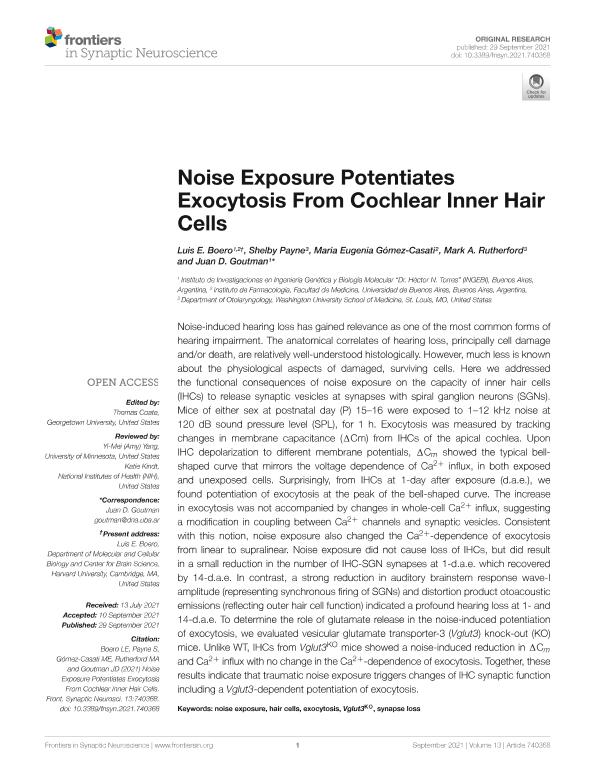Artículo
Noise Exposure Potentiates Exocytosis From Cochlear Inner Hair Cells
Boero, Luis Ezequiel ; Payne, Shelby; Gomez Casati, Maria Eugenia
; Payne, Shelby; Gomez Casati, Maria Eugenia ; Rutherford, Mark A.; Goutman, Juan Diego
; Rutherford, Mark A.; Goutman, Juan Diego
 ; Payne, Shelby; Gomez Casati, Maria Eugenia
; Payne, Shelby; Gomez Casati, Maria Eugenia ; Rutherford, Mark A.; Goutman, Juan Diego
; Rutherford, Mark A.; Goutman, Juan Diego
Fecha de publicación:
29/09/2021
Editorial:
Frontiers Media
Revista:
Frontiers in Synaptic Neuroscience
e-ISSN:
1663-3563
Idioma:
Inglés
Tipo de recurso:
Artículo publicado
Clasificación temática:
Resumen
Noise-induced hearing loss has gained relevance as one of the most common forms of hearing impairment. The anatomical correlates of hearing loss, principally cell damage and/or death, are relatively well-understood histologically. However, much less is known about the physiological aspects of damaged, surviving cells. Here we addressed the functional consequences of noise exposure on the capacity of inner hair cells (IHCs) to release synaptic vesicles at synapses with spiral ganglion neurons (SGNs). Mice of either sex at postnatal day (P) 15–16 were exposed to 1–12 kHz noise at 120 dB sound pressure level (SPL), for 1 h. Exocytosis was measured by tracking changes in membrane capacitance (1Cm) from IHCs of the apical cochlea. Upon IHC depolarization to different membrane potentials, 1Cm showed the typical bellshaped curve that mirrors the voltage dependence of Ca2+ influx, in both exposed and unexposed cells. Surprisingly, from IHCs at 1-day after exposure (d.a.e.), we found potentiation of exocytosis at the peak of the bell-shaped curve. The increase in exocytosis was not accompanied by changes in whole-cell Ca2+ influx, suggesting a modification in coupling between Ca2+ channels and synaptic vesicles. Consistent with this notion, noise exposure also changed the Ca2+-dependence of exocytosis from linear to supralinear. Noise exposure did not cause loss of IHCs, but did result in a small reduction in the number of IHC-SGN synapses at 1-d.a.e. which recovered by 14-d.a.e. In contrast, a strong reduction in auditory brainstem response wave-I amplitude (representing synchronous firing of SGNs) and distortion product otoacoustic emissions (reflecting outer hair cell function) indicated a profound hearing loss at 1- and 14-d.a.e. To determine the role of glutamate release in the noise-induced potentiation of exocytosis, we evaluated vesicular glutamate transporter-3 (Vglut3) knock-out (KO) mice. Unlike WT, IHCs from Vglut3KO mice showed a noise-induced reduction in 1Cm and Ca2+ influx with no change in the Ca2+-dependence of exocytosis. Together, these results indicate that traumatic noise exposure triggers changes of IHC synaptic function including a Vglut3-dependent potentiation of exocytosis.
Palabras clave:
EXOCYTOSIS
,
HAIR CELLS
,
NOISE EXPOSURE
,
SYNAPSE LOSS
,
VGLUT3KO
Archivos asociados
Licencia
Identificadores
Colecciones
Articulos(INGEBI)
Articulos de INST.DE INVEST.EN ING.GENETICA Y BIOL.MOLECULAR "DR. HECTOR N TORRES"
Articulos de INST.DE INVEST.EN ING.GENETICA Y BIOL.MOLECULAR "DR. HECTOR N TORRES"
Articulos(OCA HOUSSAY)
Articulos de OFICINA DE COORDINACION ADMINISTRATIVA HOUSSAY
Articulos de OFICINA DE COORDINACION ADMINISTRATIVA HOUSSAY
Citación
Boero, Luis Ezequiel; Payne, Shelby; Gomez Casati, Maria Eugenia; Rutherford, Mark A.; Goutman, Juan Diego; Noise Exposure Potentiates Exocytosis From Cochlear Inner Hair Cells; Frontiers Media; Frontiers in Synaptic Neuroscience; 13; 29-9-2021; 1-14
Compartir
Altmétricas



